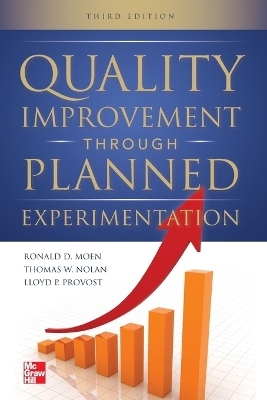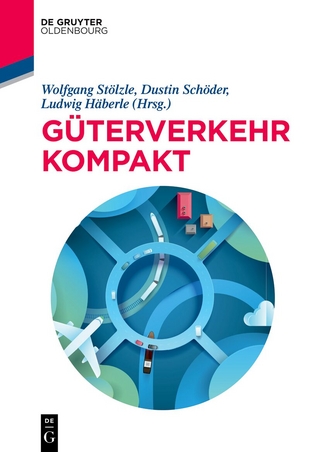
Quality Improvement Through Planned Experimentation 3E (PB)
McGraw-Hill Education (Verlag)
978-1-265-82714-4 (ISBN)
The latest experimental design techniques for quality improvement"The methods taught in this book are a major contribution to statistical methods as an aid to engineers, as well as to those in industry, education, or government who are trying to understand the meaning of fi gures derived from comparisons or experiments." -- W. EDWARDS DEMING
Co-written by three recipients of the Deming Medal awarded by the American Society for Quality (ASQ), Quality Improvement through Planned Experimentation, Third Edition discusses the principles and methodologies for planning and conductingexperiments to improve products, processes, or systems.
Fully revised with up-to-date case studies and incorporating new software, this authoritative guide fosters the sequential building of knowledge essential for implementing effective improvements. End-of-chapter exercises reinforce what you've learned, and forms for designing planned experiments help you to integrate themethods in the book into your daily work. The methods of planned experimentation provide an opportunity to better meet the needs of customers, reduce costs, and increase productivity by effecting verifiably beneficial changes.
COVERAGE INCLUDES:
* Improvement of quality * Principles for design and analysis of planned experiments * Experiments with one factor * Experiments with more than one factor * Reducing the size of experiments * Evaluating sources of variation* Sequential experimentation * Using a time series response variable * Designs with factors at more than two levels * Applications in health care * New product design
NEW: Study-it software available for download!
1991 No primary address Improving Quality Through Planned Experimentaion
Chapter 1. Improvement of Quality
Building Knowledge and the Scientific Method
Defining Quality
Model for Improvement
Sequential Experimentation Using the PDSA Cycle Chapter 2. Principles for Design and Analysis of Planned Experiments
Types of Planned Experiments
Principles for Designing Analytic Studies
Tools for Experimentation
Form for Documentation of a Planned Experiment
Analysis of Data from Analytic Studies
Chapter 3. Experiments with One Factor
General Approach to One-Factor Experiments
Using Run Charts for a One-Factor Design
Using Shewhart Charts for One-Factor Experiments
Paired-Comparison Experiments
Randomized Block Designs
Incomplete Block Designs
Chapter 4. Experiments with More Than one Factor
Introduction to Factorial Designs
Design of Factorial Experiments
Advanced Topics in the Analysis of Factorial Experiments
Chapter 5. Reducing the Size of Experiments
Introduction to Fractional Factorial Designs
Fractional Factorial Designs--Moderate Current Knowledge
Fractional Factorial Designs--Low Current Knowledge
Using Blocking to Design a Sequence of Experiments
Chapter 6. Evaluating Sources of Variation
Applications of Nested Designs
Planning and Analyzing an Experiment with Nested Factors
More Complex Nested Designs
Appendix 6a: Calculation of Variance Components
Appendix 6b: Calculating and Combining Statistics
Chapter 7. Sequential Experimentation--A Case Study
Improving a Milling Process--Getting Started
The First Improvement Cycle: Current Performance of the Mlls
The Second PDSA Cycle: Sources of Variation
The Third PDSA Cycle: Evaluating Mill Cutter Vendors
The Fourth PDSA Cycle: Screening Process Variables
The Fifth PDSA Cycle: Evaluate Effect of Improvements on the Mill Process
The Sixth PDSA Cycle: Evaluating Important Factors
The Seventh PDSA Cycle: Determining Optimum Levels
The Eighth PDSA Cycle: Confirmation of Improvements
Final Actions of the Mill Improvement Team
Chapter 8. Sequential Experimentation Using a Time Series Response Variable
Incorporating Experimental Patterns in a Time Series
Shewhart Charts
Designs for Sequential Experimentation Using Time Series Response Variables
Chapter 9. Experiments with Factors at More than Two Levels
Factorial Designs with More Than Two Levels
Augmenting 2^k Factorial Designs with Center Points
Three Level Designs for Quantitative Factors
Experiments for Formulations or Mixtures
Experimental Design for Complex Systems
Chapter 10. Applications in Healthcare
Chapter 11. New Product Design
Phase 0: Generate Ideas
Phase 1: Develop Concepts and Define Product
Phase 2: Test
Phase 3: Produce Product
Appendix A: Evaluating Measurement Systems
| Erscheint lt. Verlag | 11.7.2023 |
|---|---|
| Verlagsort | OH |
| Sprache | englisch |
| Gewicht | 662 g |
| Themenwelt | Technik ► Maschinenbau |
| Wirtschaft ► Betriebswirtschaft / Management ► Logistik / Produktion | |
| ISBN-10 | 1-265-82714-1 / 1265827141 |
| ISBN-13 | 978-1-265-82714-4 / 9781265827144 |
| Zustand | Neuware |
| Haben Sie eine Frage zum Produkt? |
aus dem Bereich


